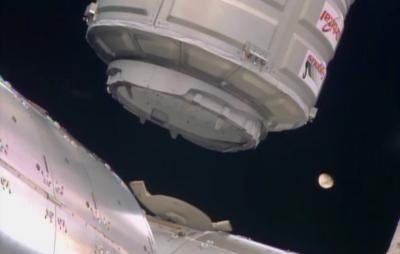Tue, Jan 14, 2014
Commercial Resupply Spacecraft Cygnus Spacecraft Docked At ISS Sunday
The commercial space industry took another step forward Sunday as astronauts aboard the International Space Station used a robotic arm to capture and attach the Cygnus supply spacecraft, which carried dozens of new science experiments from across the country and the world to the orbiting laboratory. The arrival capped the first successful contracted cargo delivery by Orbital Sciences Corp. of Dulles, VA for NASA.

Astronaut Mike Hopkins of NASA grappled the spacecraft at 0608 EST and Koichi Wakata of the Japan Aerospace Exploration Agency attached Cygnus to the space station's Harmony Node at 0805. The Expedition 38 crew members aboard the station will begin unloading the 2,780 pounds of supplies aboard Cygnus following hatch opening planned for Monday.
The cargo is comprised of vital science experiments, crew provisions, spare parts and other hardware. This includes 23 student-designed science experiments. One newly arrived investigation will study the decreased effectiveness of antibiotics during spaceflight. Another will examine how different fuel samples burn in microgravity, which could inform future design for spacecraft materials.
Orbital's Cygnus was launched on the company's Antares rocket Thursday from the Mid-Atlantic Regional Spaceport Pad 0A at NASA’s Wallops Flight Facility in Virginia. Cygnus will remain attached to Harmony until a planned unberthing in February sends the spacecraft toward a destructive re-entry in Earth's atmosphere.
Orbital Sciences is one of two companies that built and tested new cargo spacecraft under NASA's Commercial Orbital Transportation Services (COTS) program. COTS was completed late last year with an Orbital Sciences demonstration mission to the space station. Space Exploration Technologies (SpaceX), the other company that partnered with NASA under COTS, also is providing commercial resupply services for the agency. U.S. commercial cargo delivery flights to the station help ensure a robust national capability to deliver critical science research to orbit, significantly increasing NASA's ability to conduct new science investigations aboard the only laboratory in microgravity.
In addition to cargo flights, NASA's commercial space partners are making progress toward a launch of astronauts from U.S. soil within the next three years.
(Image provided by NASA)
More News
With Testing Soon Complete, Launch Preparations Begin in Earnest Sierra Space's Dream Chaser has been put through the wringer at NASA's Glenn Armstrong Test Facility in Ohio, but w>[...]
Takeoff Roll The process whereby an aircraft is aligned with the runway centerline and the aircraft is moving with the intent to take off. For helicopters, this pertains to the act>[...]
“We’re proud of the hard work that went into receiving this validation, and it will be a welcome relief to our customers in the European Union. We couldn’t be mor>[...]
"Aircraft Spruce is pleased to announce the acquisition of the parts distribution operations of Wag-Aero. Wag-Aero was founded in the 1960’s by Dick and Bobbie Wagner in the >[...]
IDENT Feature The special feature in the Air Traffic Control Radar Beacon System (ATCRBS) equipment. It is used to immediately distinguish one displayed beacon target from other be>[...]
 Sierra Space Repositions Dream Chaser for First Mission
Sierra Space Repositions Dream Chaser for First Mission ANN's Daily Aero-Term (05.10.24): Takeoff Roll
ANN's Daily Aero-Term (05.10.24): Takeoff Roll Aero-News: Quote of the Day (05.10.24)
Aero-News: Quote of the Day (05.10.24) Aero-News: Quote of the Day (05.11.24)
Aero-News: Quote of the Day (05.11.24) ANN's Daily Aero-Term (05.11.24): IDENT Feature
ANN's Daily Aero-Term (05.11.24): IDENT Feature



